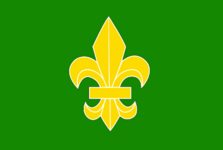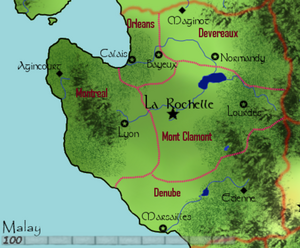Malay
Overview
Once part of the vast kingdom of Imajicka, Malay has been a coherent entity for more than a thousand years. It is a rare constitutional monarchy headed King Jean-Michelle Mont Clamont, who presides over the Chambre des Pairs (House of Peers) and Assemblée Nationale (National Assembly). Malay is located on the west coast of Eurus, bordered on the north by Doomstadt, with Abruzzo to the south, Helvetia and Oguz to the east. The capital of Malay is La Rochelle, located in the duchy of Mont Clamont.
Malay has some of the most fertile land in Eurus with broad grain and fruit producing regions throughout the central lowlands, while also having austere boreal mountains in its eastern portions and a selection of coastal highlands. Almost all land in Malay is agriculturally fruitful, with variation sufficient to make it resilient to regional devastations that might cripple a smaller nation's economy.
Aristocrats retain a great deal of power in Malay, despite the parliamentary structure of government, leaving the bourgoisie and proletariat classes trailing in their wake, but there is more upward mobility possible, if not necessarily likely, in Malay than in many other countries. The people of Malay tend to pride themselves on being very secular and not deeply concerned with religious affairs, but hold to the Thracian pantheon generally.
The most modern incarnation of Malay as a sovereign nation came about in 2001 with the dissolution of Imajicka, but much of the structure under which it governs itself was simply perpetuated from its lengthy time as a duchy under Imajickan control, including the parliamentary system. In 2017, Malay ended a short-lived war with the nation of Alba that was brought on by a wide array of long-standing disputes, and the two countries remain frequently at loggerheads.
Culture
Culture found in land
Religions
While the Thracian Pantheon holds a moderately popular presence in Malay and is the most prominent of religious traditions, there is a modern tendency to eschew the particulars of religious faith in favor of civic duty and national pride, making something nearly to a state religion out of secularism itself.
Social Structure
The aristocracy in Malay still holds much of the social power. Aristocrats own the land, function in magisterial capacity over their own lands, and control absolutely one half of the bicameral parliament. As the highest of the nobility, the King or Queen still retains a vast amount of power and political capital as well, but this is all tempered somewhat by the presence of the Parliament, where the Bourgeoisie (merchant class) hold firmly to the lower house. Additionally, social mobility has increased to the extent that the wealthiest of merchants can buy their way into the nobility, whether by marriage or the assumption of debts. The lower class of proletariat (called proles by the upper class) are the common workers within the land. They can stand for election as local government officials and even for the Assemblée Nationale, but attain that status only infrequently. While Malay espouses reverence for the advancement possible through personal will and achievement rather than the advantages of birth, this level of idealism is more frequently used as a reflexive self-justification by the rich for their own status.
Customs and Holidays
What days matter to the people
Arts and Exceptionalism
Politics
Government
Malay is a parliamentary monarchy. The Crown is hereditary and is passed to the eldest living child of either gender, as are all noble titles within Malay. The head of each noble household has a seat in the Chambre des Pairs in parliament. The Assemblée Nationale is made up of elected officials from all over Malay. All laws must first pass the Chambre before coming before the Assemblée. Any law passing both is sent to the King. The King may set aside any law, but a supermajority vote of all members of Parliament can in theory override the King. Members of the Chambre serve for life or until they turn over their titles to an heir. Members of the Assemblée serve for 3 years.
Malay maintains a small standing army, relying more on its wealth and ability to hire mercenary assistance and uses pro tempore conscription of the personal militias of the aristocracy as necessary to expand those ranks. Similar systems are in place for the navy, which has a small number of spectacularly armed vessels but leases most of its actual fighting strength to guard merchant shipping.
The most elite force of the military in Malay is the Garde Éclair or "Lightning Guard." These serve as the personal bodyguards of the royal family.
Organization of the Land
How the power structure is divided regional (i.e. Duchies, Baronies, Lordships, etc.)
Demographics
Economy
Foreign Relations
History
History since the Dragon Wars
Early History
National History
Major Modern Events
When the Kingdom of Imajicka was disbanded by Olanna De Vane in 2001 Malay went through a period of upheaval. Many of the noble houses wanted to declare Malay a feudal society again. The Duke of Malay at the time was Jean Michel Mont Clamont, a descent of Eleanor of Chardonay. Mont Clamont saw that the people of Malay would not stand for another oppressive monarchy and convened a council of the nobles of Malay. To their surprise, he also invited the mayors and major land owners from outside of the nobility. He laid out his plan for the forming of a parliament and his in statement as King of Malay. The lower classes rallied their support around Mont Clamont and the nobility had little choice but to acquiesce.
A group of black hulled ships hit the south coast of Malay a few years later. Marseilles was sacked as were many other towns along the coast. The militia was formed together and the people threw the invaders back into the sea, towards Alba, ultimately leading to a rogue Bridaini invasion of parts of Alba.
Tensions between rival factions within Doomstadt embroiled Malay in its civil war from 2007-2013. The Malayan government lent aid to the southern Houses of Doomstadt in order to secure a more binding non-aggression agreement with them, the point of which is to secure Malays northern border. With Alba providing aid for the northern Houses of Doomstadt, tensions between Malay and Alba increased until reaching a breaking point. After the Treaty of Geissen and the end of Doomstadt's civil war, tensions moved to outright hostility and Malay became embroiled in a true, rather than proxy, war with Alba. This was precipitated by lingering resentments associated with the financial particulars of the dissolution of Imajicka, Malay's contributions to the Doomstadt civil war, and an assassination attempt upon Queen Fumiko Van Dance of Alba with the alleged aid of several Malayan noblemen whom the government would not relinquish to Alban justice.
The war began with naval confrontations and moved to substantial Alban occupation of central malayan grain country, and ultimately ended diplomatically in 2017 when Malay signed a convoluted treaty which amounted to an unispiring but meaningful financial win for Alba in exchange for a cessation of hostilities. The two nations retain a mutual distrust and dissatisfaction after the resolution of the affair.
Geography
The physical lay of the land
Notable Features
Malay is blessed with a pleasant climate and abundant natural resources. The central half of the country is given over to rich farmland, with forests to the south and east into the foothills of the Dragonspine Mountains, and the lesser mountains to the northwest in the duchy of Montreal.
The largest lake in Malay is Lac du Criziel, located in central Mont Clamont. It is fed by the Haute Seine or "Upper Seine" river, which passes through the capital of La Rochelle. The Seine is considered to then depart the vast lake as the Seine Maratime, which flows all the way to the Alban Channel. Another major river is the Denube in southern Malay, which flows through the duchy of the same name.
Malay has two main ports, Calais in the North near the Alban Channel, and Marseille in the south near the border with Abruzzo.
The well-cultivated forests of Dijon cover a substantial portion of eastern Malay and provide immense resources in lumbar for export. The coastline is rugged in some place and is subject to rough storms, especially in the south, but also has a great many sheltered coves and harbors.

